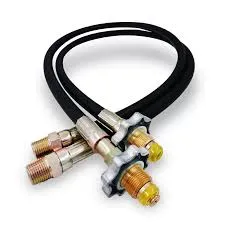335345435
Nov . 08, 2024 23:14 Back to list
Understanding the Importance of Gasoline Tank Hoses in Fuel Systems
Understanding the Gasoline Tank Hose Importance, Function, and Maintenance
The gasoline tank hose is an essential component of any vehicle’s fuel system, serving as the critical link between the fuel tank and the engine. Its primary function is to transport gasoline safely and efficiently, ensuring that the engine receives the fuel it needs for optimal performance. Despite its significance, many vehicle owners overlook the importance of this critical component. In this article, we will explore the functions of the gasoline tank hose, common issues that may arise, and tips for maintenance.
The Function of the Gasoline Tank Hose
The gasoline tank hose is designed to withstand the harsh conditions of the automotive environment. Made from durable materials, it is built to handle the corrosive nature of gasoline, along with varying temperatures and pressures. The hose is flexible, allowing for easy routing in tight spaces within the vehicle's chassis.
One of the primary functions of the gasoline tank hose is to transport fuel from the tank to the engine's fuel injection system. This process requires a steady flow of gasoline, which the hose facilitates through its design. Moreover, it is crucial that the hose maintains a tight seal to prevent leaks. A compromised hose can lead to fuel spills, which not only waste valuable gasoline but also pose significant safety hazards, including fire risks.
Common Issues with Gasoline Tank Hoses
Over time, gasoline tank hoses can develop issues due to exposure to fuel and environmental factors. One common problem is cracking or deterioration of the hose material, caused by age and exposure to heat. This degradation can result in leaks, which not only reduce fuel efficiency but can also lead to dangerous situations.
Another potential issue is hose kinking or bending, which can restrict fuel flow to the engine. This restriction may lead to poor engine performance, including stalling or difficulty starting. Additionally, if the gasoline tank hose is not properly secured, it can come loose, leading to more severe complications.
Maintenance Tips for Gasoline Tank Hoses
gasoline tank hose

Maintaining your gasoline tank hose is crucial for ensuring its longevity and optimal performance. Here are some helpful tips
1. Regular Inspections Periodically inspect the gasoline tank hose for any signs of wear and tear. Look for cracks, leaks, or changes in texture. If you notice any damage, replace the hose immediately to prevent further issues.
2. Keep It Clean Ensure that the area around the gasoline tank hose is free from dirt, debris, and other contaminants that could affect its condition. Cleaning the area can also help you better identify any potential issues.
3. Avoid Overheating High temperatures can hasten the deterioration of gasoline hoses. Ensure that the hose is not positioned adjacent to hot engine components to reduce overheating risks.
4. Secure Connections Make sure that all connections are secure. Loose connections can lead to leaks and poor fuel delivery, which can affect engine performance.
5. Professional Inspections If you’re unsure about the condition of your gasoline tank hose, consider having a professional mechanic perform an inspection. They can identify issues that may not be readily apparent to the untrained eye.
Conclusion
The gasoline tank hose is a small yet vital component of your vehicle’s fuel system. Understanding its role enhances your appreciation for its significance and underscores the necessity of regular maintenance. By taking proactive steps to inspect and care for your gasoline tank hose, you can ensure that your vehicle runs smoothly and safely, while also contributing to a more fuel-efficient driving experience. Remember, when it comes to vehicle maintenance, paying attention to the small details, like the gasoline tank hose, can prevent significant problems down the road.
-
High-Quality Distribution PTFE Hose for Industrial Flexibility
NewsJul.23,2025
-
Durable Pressure Washer Rubber Hose for Hot Water & High Flexibility
NewsJul.22,2025
-
Twin Hydraulic Hose for Efficient Fluid Transfer | Durable & Flexible
NewsJul.22,2025
-
Twin Hydraulic Hose | High Pressure & Durable
NewsJul.21,2025
-
Discount Hydraulic Hose Factories | Top Quality & Discounts
NewsJul.20,2025
-
EN856 4SP Hydraulic Hose - High Pressure & Durable
NewsJul.20,2025



